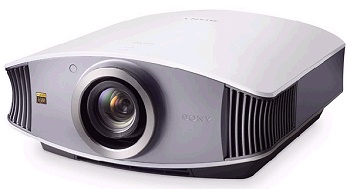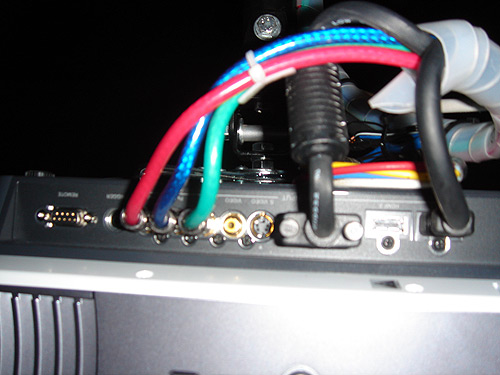|
|
 |
|
Specifications:
● Resolution: 1920x1080
(1080p)
● Display Type:
Three 0.6" SXRD panels: 16:9
● Brightness: 900 ANSI Lumens
● Contrast Ratio: 15,000:1
● Lens: Power Zoom Lens; 1.72:1; Power Focus
● Lens Shift: Electronic Vertical Shift
● Keystone Correction: Digital
● Dynamic Iris
● Inputs: HDMI with HDCP x 2, VGA x 1, Component
Video x 1, S-Video x 1, Composite Video x 1, RS-
232 x 1
● Dimensions: 6.8" H x 15.6" W x 18.6" D
● Weight: 24 Pounds
● MSRP: $5,000 USA
Sony
www.sony.com
|
|
Introduction
A few years ago, a friend of mine called me to his house
where he proudly
showed me his new toy: a genuine JVC HD2K projector with a William Phelps uniformity
calibration.
I've seen the HD2K (one of the first LCoS projectors under the
JVC moniker "D-ILA") shown in a few demos in exhibitions with OEM configurations
(Faroudja theater), but I distinctly remember how realistic the image was
and how amazing the details were. It was just a gorgeous,
brilliant picture (kudos to Mr. William Phelps, of course). The downside of
the HD2K was a contrast ratio that was too low, which made blacks
way too gray.
This was way back when 1920 x 1080 HD projectors were a novelty (hmm, that's
still true today), and cost $20,000 a pop.
I remember remarking on how smooth and film-like the image was and how much
less tiring it was from single-chip DLP.
Sony's first endeavor at consumer 1920 x 1080 was
the Qualia 004, which used SXRD panels. It was very expensive. Then, Sony broke the price barrier when they introduced
the Ruby (VPL-VW100) - pricing it at an even $10,000.
The Pearl
This year, Sony introduced
the VPL-VW50 (codename "Pearl"), which is also a 1920 x 1080
projector - dropping the MSRP to
$5000, with street prices less than $4000.
SXRD is a variation on the LCD idea. Whereas a conventional LCD projector has a
transparent LCD panel that passes or blocks light that is driven through
it, the LCoS/SXRD idea is that the LCD layer is placed on top of a
reflective silicon base. The light goes through the panel to the mirror, and
then is reflected back through the panel. This way, the LCD pixels have two
chances to control the light, and it improves contrast.
The Pearl uses the same optical engine as its predecessors, the Ruby and
the Qualia 004. This is a three-panel SXRD 1080 x 1920 HD projector utilizing an
advanced iris system. The Pearl packaging is smaller than the Ruby's and
uses a standard 200 watt UHP lamp instead of the more accurate, but short-lived
400 watt Xenon Ruby lamp. Using UHP means that the Pearl's design is much more
standardized and this helps Sony reduce costs.
I read with growing anticipation about the Pearl and was ecstatic when I
was informed that a brand new Pearl just arrived at a nearby dealer's
theater. When I went there, the Pearl was already installed on the ceiling,
projecting onto quite a large 1.1 gain screen. A more ideal screen would be
the one co-designed by Stewart Filmscreen and Sony specifically for this
projector.
In any case, this projector does not do well when
projected onto an overly large screen. I would keep the size at
between 90-100" diagonal. This is due to a few factors, but mostly
because
the projector has a specification of 900 lumens output (this is with all
brightness capabilities turned up to the maximum,
so you can figure that about 40% of this brightness is usable when the
projector is calibrated, i.e., you would be watching movies at about 400
lumens output).
The vertical lens shift (up to two picture lengths) and focus are remote
controlled. There is no horizontal lens shift control, but the projector
includes a software based keystone correction. As always, it is best to
try and avoid keystone correction, as this results in a loss of
resolution.
The projector was designed to be rear
shelf friendly, with heating vents to the front of the unit and the input
connectors set nicely at the sides. That does not mean Sony neglected to
support people who choose to install the unit in the middle of the room
(as our installation was), because it has IR inputs to the front and back of
the chassis.
Input connectors include two HDMI, one component, one
S-Video, one composite, one RS-232, and one VGA.

Sony did a terrific job at designing the projector. It is not quite as
large as some 1080p projectors, but it is not small. The
design is very "Sony-ish", which gives you a warm and comfortable
feeling, and is not overly flashy. I would personally prefer a black or
silver finish (less reflections back from the screen), but the VW50 looks so
good, I can overcome those feelings if I am forced to have one in my home
;->
Click Here to Go to Part II.
Terms and Conditions of Use
|






